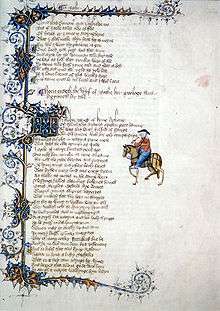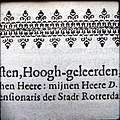Fleuron (typography)
A fleuron (/ˈflʊərɒn, -ən, ˈflɜːrɒn, -ən/;[1], for example ❦, is a typographic element, or glyph, used either as a punctuation mark or as an ornament for typographic compositions. Fleurons are stylized forms of flowers or leaves; the term derives from the Old French: floron ("flower").[2] Robert Bringhurst in The Elements of Typographic Style calls the forms "horticultural dingbats".[3] It is also known as a printers' flower, or more formally as an aldus leaf (after Italian Renaissance printer Aldus Manutius), hedera leaf ("ivy leaf"), or simply hedera symbol.
| ❦ | |
|---|---|
Fleuron | |
| In Unicode | U+2766 ❦ FLORAL HEART |
| Related | |
| See also | U+2042 ⁂ ASTERISM U+00B6 ¶ PILCROW |
History
One of the oldest typographic ornaments, in early Greek and Latin texts, the hedera was used as an inline character to divide paragraphs, similarly to the pilcrow.[4] It can also be used to fill the white space that results from the indentation of the first line of a paragraph,[5] on a line by itself to divide paragraphs in a highly stylized way, to divide lists, or for pure ornamentation.[6]
In more modern historic books, line breaks became more common as paragraph dividers, and fleurons became popular to create ornamented borders. Fleurons were crafted the same way as other typographic elements were: as individual metal sorts that could be fit into the printer's compositions alongside letters and numbers. This saved the printer time and effort in producing ornamentation. Because the sorts could be produced in multiples, printers could build up borders with repeating patterns of fleurons.
Unicode
In Unicode standards, the Symbols category includes fleurons referred to as "floral hearts" in the Dingbats and Miscellaneous Symbols blocks:
- U+2766 ❦ FLORAL HEART (HTML
❦) (Dingbats) - U+2767 ❧ ROTATED FLORAL HEART BULLET (HTML
❧) (Dingbats) - U+2619 ☙ REVERSED ROTATED FLORAL HEART BULLET (HTML
☙) (Miscellaneous Symbols)
Twenty-four fleurons originally found in the Wingdings and Wingdings 2 fonts have been included in Unicode 7.0 under the Ornamental Dingbats block.
| Ornamental Dingbats[1] Official Unicode Consortium code chart (PDF) | ||||||||||||||||
| 0 | 1 | 2 | 3 | 4 | 5 | 6 | 7 | 8 | 9 | A | B | C | D | E | F | |
| U+1F65x | 🙐 | 🙑 | 🙒 | 🙓 | 🙔 | 🙕 | 🙖 | 🙗 | 🙘 | 🙙 | 🙚 | 🙛 | 🙜 | 🙝 | 🙞 | 🙟 |
| U+1F66x | 🙠 | 🙡 | 🙢 | 🙣 | 🙤 | 🙥 | 🙦 | 🙧 | 🙨 | 🙩 | 🙪 | 🙫 | 🙬 | 🙭 | 🙮 | 🙯 |
| U+1F67x | 🙰 | 🙱 | 🙲 | 🙳 | 🙴 | 🙵 | 🙶 | 🙷 | 🙸 | 🙹 | 🙺 | 🙻 | 🙼 | 🙽 | 🙾 | 🙿 |
Notes
| ||||||||||||||||
Gallery
 Early printers sought to use fleurons to replicate the style of manuscripts like this one.
Early printers sought to use fleurons to replicate the style of manuscripts like this one..jpg) The arabesque title page of a 1611 book.
The arabesque title page of a 1611 book. Detail of a printed arabesque border in a 1616 book.
Detail of a printed arabesque border in a 1616 book. Specimens of printed floral borders from an 1897 type foundry specimen book.
Specimens of printed floral borders from an 1897 type foundry specimen book. Ornamented borders by Thomas Maitland Cleland, 1923.
Ornamented borders by Thomas Maitland Cleland, 1923. Example fleuron glyphs from a digital font.
Example fleuron glyphs from a digital font.
See also
- The Fleuron, a British typography magazine from the early 20th century.
References
- "fleuron". Collins English Dictionary.
- "Fleuron". Dictionary.com. Dictionary.reference.com. Retrieved 2013-12-24.
- Bringhurst, Robert, The Elements of Typographic Style, Second edition: Hartley and Marks Publishers, 1996. ISBN 0-88179-132-6
- "History of Graphic Design: Rare Books Collection: The Pilcrow". Mikemichelleapril.blogspot.com. 2008-09-29. Retrieved 2013-12-24.
- "Typographic Marks Unknown – @retinart". Retinart.net. Retrieved 2013-12-24.
- Lisa Ferlazzo (May 10, 2013). "Punctuation graveyard: The Hedera". theworddict.com. Archived from the original on October 29, 2013.
External links
| Wikimedia Commons has media related to |